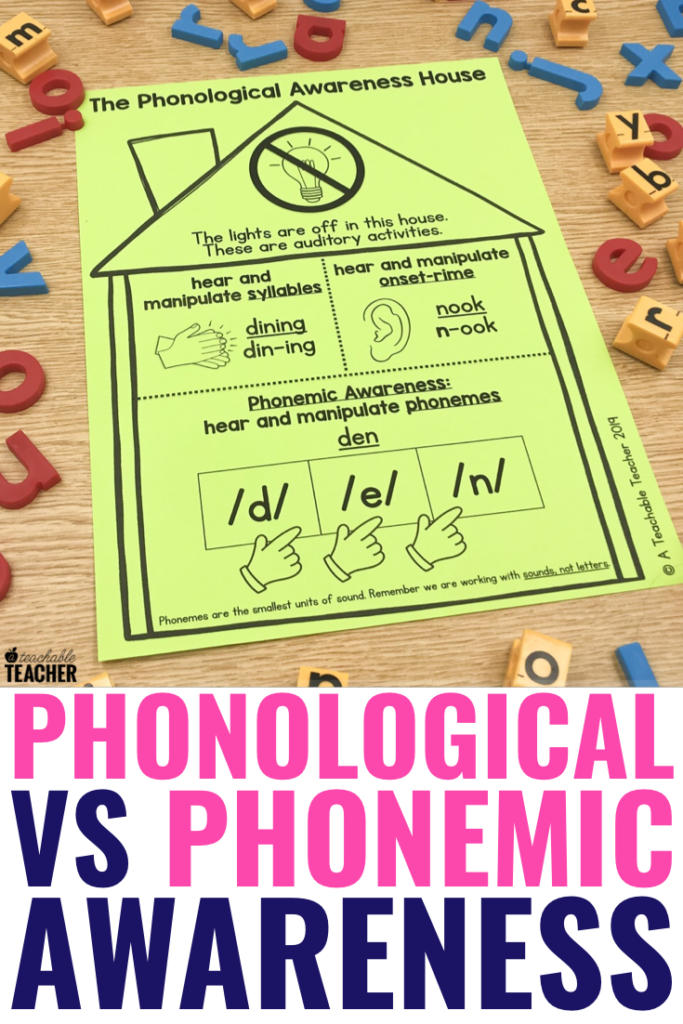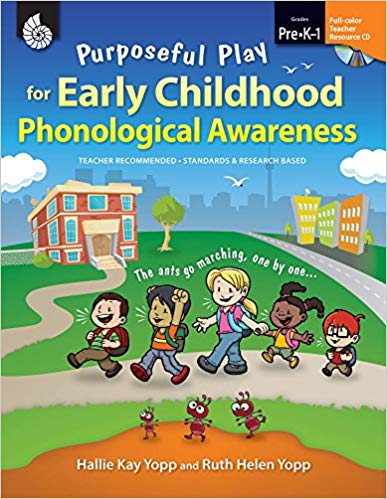Phonological awareness vs phonemic awareness: what is the difference really? How do these differences impact instruction and the way new readers learn? If you are asking these questions, read on. We can learn together! I researched it and explained it all here. 👏
Phonological awareness vs phonemic awareness can be very confusing. In teaching, the terms phonological awareness and phonemic awareness are often used interchangeably. It makes sense. Not only do they look and sound similar, they mean something similar, too.
I’m guilty. 🙋🏽♀️ I used to use them interchangeably. ? (Tell me I’m not alone here, please!)
But to be honest, once you learn the difference between the two, it’s pretty easy to remember! So, let’s dive in!

This post contains affiliate links. By purchasing through this link, we get a small commission. Rest assured – we only share links to products that we know and love!
Phonological VS Phonemic Awareness: The Ultimate Breakdown
What is phonological awareness?
Phonological awareness is the ability to hear and manipulate units of sounds in spoken language.
A unit of sound occurs within a word. For example, the word apple.
You hear /ap/ and /ple/. There are two syllables that we hear. Those are units of sound.
If you’re able to hear those two sounds (syllables) in the word, you have phonological awareness.
The following are all units of sounds within a word, organized from largest unit of sound to smallest unit of sound.
- Syllables
- Onset
- Rime
- Phonemes
Note on Manipulating Sounds (for both Phonological and Phonemic Awareness)
Before we get into the difference between phonological and phonemic awareness, I wanted to make sure we were on the same page about what it means to manipulate sounds.
In all of these examples, let’s manipulate phonemes for the word dog. When you see / / around a letter, it refers to the letter sound, not the letter name.
- Blending Sounds – Put these sounds together /d/ /o/ /g/ >> dog
- Segmenting Sounds – Separate these sounds dog >> /d/ /o/ /g/
- Adding Sounds – Add /s/ to the end of dog >> dogs
- Deleting Sounds – Say dog without /d/ >> og
- Substituting Sounds – The word is dog. Instead of /d/, let’s say /f/ >> fog.
Examples of phonological awareness activities
Phonological awareness activities include manipulating sounds (see above ??) with syllables, onsets, rimes, and phonemes.
For example:
- Segmenting syllables
- What parts do you hear in rainbow? >> rain and bow
- Deleting rimes
- Say pencil without cil. >> pen
- Isolating phonemes
- What’s the first sound you hear in cup? >> /k/
- Blending onset and rime
- What happens if we put ch and in together? >> chin
- Matching phonemes
- What’s another word that starts like lap? >> like (or any word that starts with /l/)
What is phonemic awareness?
Phonemic awareness is the ability to hear and manipulate the smallest unit of sound in spoken language.
The smallest unit of sound in the English language is called a phoneme.
Did you know there are 43 phonemes in the English language?
Confusing when there are only 26 letters, isn’t it? Don’t worry, in phonemic awareness we are focusing on sounds and not letters.
Examples of phonemic awareness activities
Phonemic awareness activities involve the smallest units of sound only.
For example, being able to hear /c/ and /a/ and /t/ in the word cat requires phonemic awareness.
Another example would being able to hear /sh/ and /a/ and /ck/ in the word shack.
These sounds cannot be any smaller. You cannot break down the /k/ sound. You cannot break down the /sh/ sound. (Even though it has two letters, they only make one sound). The same can be said for /ck/, too.
Phonemic awareness involves being able to hear and manipulate phonemes, the smallest units of sound.
How are phonological awareness and phonemic awareness different?
Phonological awareness is about being able to hear and manipulate units of sound in spoken words. That includes syllables, onset, rime, and phonemes.
Phonemic awareness is about the being able to hear and manipulate the smallest unit of sound, a phoneme!
How are phonological awareness and phonemic awareness the same?
Phonemic awareness is a part of phonological awareness.
If phonological awareness was a house 🏠, phonemic awareness would be one of the rooms. I would venture to say that it’s the kitchen or family room, because it’s usually the area of phonological awareness that we as reading teachers spend the most time in.
For example, counting the number of syllables in a word would be a phonological awareness activity. (We are working with syllables.)
Counting the number of sounds in a word would be a phonemic awareness activity. We are working with phonemes. This means it is also a phonological awareness activity (we are working with a unit of sound).
Phonological awareness and phonemic awareness both focus on the sounds that we hear, and not the letters that we see.
When you think of them, remember that they can be done in the dark.
What does that mean?
- They are listening and speaking activities
- They don’t involve letters (yet!)
Let’s think about it: Count the number of syllables in a word in the dark.
Say and clap, cat.
Clap! One syllable. You can do that with the lights off.
You can blend sounds to make a word in the dark.
Put these sounds together: /c/ /a/ /t/. What’s the word? Cat! You can listen and blend these sounds together in the dark. It’s about what you hear.
Now, in order to read the word cat, students would need to see the letters: c, a, t, and sound them out.
They would need the lights on. ? In this case, we are talking about phonics. It involves letters and sounds. That letter-sound relationship is phonics, not phonological or phonemic awareness.
Now, this doesn’t mean it’s bad to practice this way.
You still need to practice blending and segmenting sounds in words using letters. But that comes with phonics activities, not phonemic awareness activities.
Before (or while) we learn phonics, we have to build phonological (and phonemic) awareness!
Why do Phonological awareness and phonemic awareness matter?
Phonological awareness is one of the strongest predictors of reading success.
In other words, students are going to have a very difficult time learning and implementing phonics in reading if they don’t have phonological awareness. (Remember, that includes phonemic awareness, too!).
How can a student sound out c-a-t (decode the word) if they can’t hear the three individual sounds (phonemes) that make up the word? They can’t!
This is why it’s so important that students are able to hear, blend, and segment sounds in words before learning to read using phonics.
Phonological awareness VS phonemic awareness cheat sheet
Now, if you accidentally interchange these terms (like I used to do 🙋🏽♀️), does it mean that your students won’t learn how to read? Of course not! But, does that mean we want to use the terms incorrectly? Also, of course not! 😉
A lot of my resources are tagged with phonemic awareness as the main topic or category because the majority of the instruction/practice involves manipulating phonemes. After all, learning to segment and blend sounds in words is the most important aspect of phonological awareness.
However, when practicing manipulating sounds, it’s extremely common to start with words and syllables, and then move to onset and rime, and finally, to phonemes. Why? It’s a logical progression! Start big, work your way towards small. This is why you may see (or use) the term phonemic awareness on an activity that has a warm-up involving syllables and/or onset and rimes.
To help you remember the difference between phonological awareness and phonemic awareness, I made you this quick cheat sheet!

Click to the download the Phonological VS Phonemic Awareness Teacher Cheat Sheet!
Professional Development on Phonological and Phonemic Awareness
This section contains affiliate links. By purchasing through this link, we get a small commission that helps support the blog (at no cost to you). Rest assured we only share links to products that we know and love!
Here are some books on phonological and phonemic awareness that I love!
Phonological Awareness: From Research to Practice by Gail T. Gillon
Purposeful Play for Early Childhood Phonological Awareness by Hallie Kay Yopp and Ruth Helen Yopp
Do you have any recommendations? Feel free to share them with us in the comments below! 👇













